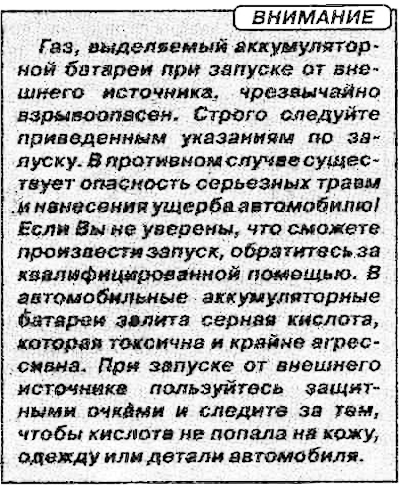
Engine does not crank or cranks slowly with starter

1. On an automatic transmission vehicle, make sure the selector lever is in the «N» or «R» and that the parking brake is on.
2. Check the connection and cleanliness of the battery wires.
3. Turn on interior lighting. If the light dims or goes out when the starter is engaged, this indicates that the battery is low.
4. Check up reliability of connection of wires to a starter.
5. Do not start the engine by pushing or towing. See below subsection «Starting the engine from an external current source».
Engine cranks normally with starter, but won't start
1. Check the fuel level.
2. Check the reliability of all connections of the ignition system, coil and spark plugs. Repair disconnected or weak connections.
3. Check the fuel lines in the engine compartment.
4. If the engine still does not start after this, contact your Hyundai dealer or other qualified service for assistance.
Engine stalled while driving
1. Reduce speed slowly while continuing to drive in a straight line. Turn off the road carefully in a safe place.
2. Turn on the alarm.
3. Try to start the engine. If it does not start, contact your Hyundai dealer or other qualified assistance.
Starting the engine from an external current source


If acid comes into contact with clothing, skin, or eyes, immediately remove clothing and flush affected areas with clean water for at least 15 minutes. Then seek medical attention as soon as possible. If transported to a medical facility, continue rinsing the affected areas with a sponge or cloth.
The gas given off by a battery when starting from an external source is extremely explosive. Do not smoke and keep away from sparks and open flames.
The external battery used for starting must be 12V. If the battery voltage cannot be determined, do not use it for starting.
Starting the engine from an external current source with a discharged car battery is carried out in strict accordance with the following instructions:
1. If the external battery is installed in another car, make sure that the cars do not touch each other.
2. Turn off all unnecessary lights and accessories on both vehicles.
3. Connect the wires to the battery terminals as shown in the illustrations on the previous page. First connect the wire clamp to the positive («+») terminal or wire of a discharged battery. Then connect the clamp on the other end of the same wire to the positive terminal («+») or external battery cable. After that, connect the clamp of the second wire to the negative terminal («-») or external battery wire, then attach the other clamp of the same wire to some heavy metal part of the engine away from the battery. Do not connect the wire to any moving part.
4. Start the vehicle with the starting battery and let it run for a few minutes to recharge the battery. When starting the engine with a dead battery, increase the engine speed of the donor vehicle to about 2000 rpm.
5. Start your car engine in the normal way. After starting the engine, without disconnecting it from the external battery, let it run for several minutes at fast idle or at a speed of about 2000 rpm.
6. Carefully disconnect the connecting wires in the reverse order of their connection.
If the cause of the battery discharge is not clear (the cause may be the failure to turn off the outdoor lighting, etc.), have the battery charging circuit checked by a Hyundai dealer.
Engine overheating
If the coolant temperature gauge needle is in the overheating zone, a drop in engine power is felt, or a loud or dull engine knock is heard, then the engine is probably overheating. If this happens, you must:
1. Turn off the roadway and stop in a safe place.
2. Set the selector lever to position «R» (by car with automatic transmission) or switch to neutral (by car with automatic transmission) and apply the parking brake. If the air conditioner is running, turn it off.
3. If coolant is leaking from under the vehicle or steam is coming out from under the hood, stop the engine. Do not open the hood until the coolant stops flowing or steam from under the hood stops. If there are no visible coolant leaks or fumes, keep the engine running and check that the cooling fan is working. If the fan does not work, stop the engine.
4. Check if the water pump drive belt is in place. If it is in place, check its tension. If the belt is OK, check for coolant leaks from the radiator, hoses and under the vehicle (condensation from the air conditioner flows under a parked car, if it is turned on).


5. If the water pump drive belt breaks or coolant leaks, stop the engine immediately and contact your nearest Hyundai dealer for assistance.

6. If you are unable to determine the cause of overheating, wait until the engine has cooled down to normal temperature. Then, if there is a coolant leak, carefully open the radiator cap and add enough coolant to it so that its level is between the marks on the expansion tank.
7. Continue driving carefully, watching for signs of overheating again. If the engine overheats again, contact your Hyundai dealer for assistance.


